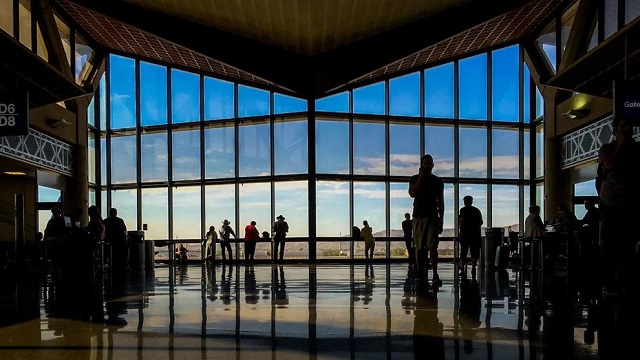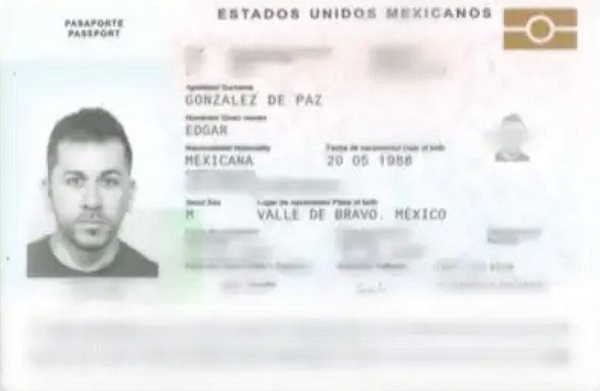illegal immigration
It’s not just Springfield, Haitians being flown to small towns nationwide

From The Center Square
By
Haitians are not just arriving in Springfield, Ohio, but also in small rural towns nationwide as a result of several Biden-Harris administration policies.
Since fiscal 2021, more than 485,000 Haitian illegal border crossers, a record, have been reported by U.S. Customs and Border Protection. The overwhelming majority were reported this fiscal year, nearly 216,000, compared to 48,727 in fiscal 2021.
Since fiscal 2021 through August, the majority have been apprehended at the southwest border of nearly 262,000, followed by nearly 221,000 nationwide and nearly 2,300 at the northern border, according to the data.
Additionally, since July, 205,000 Haitians have been released through the CHNV parole program, according to CBP data. Of the more than 765,000 illegal foreign nationals released into the country through the CBP One app, the top nationality is Haitian. Through these programs, U.S. Department of Homeland Security Secretary Alejandro Mayorkas also extended Temporary Permanent Status to them and granted work authorization.
All of these programs are illegal, state attorneys general who’ve sued to stop them, argue. U.S. House Republicans also cited them as among the many illegal actions Mayorkas caused them to impeach him. Mayorkas has since only expanded the programs and extended TPS.
When responding to the Haitian influx, local officials claim Haitians are there to work and are contributing to society despite claims by residents to the contrary.
The city of Springfield claims a “surge in our population over the last several years, primarily due to an influx of legal immigrants,” suggesting that Springfield “is an appealing place for many reasons including lower cost of living and available work.”
Springfield Mayor Bob Rue has said “my hands are tied in many ways” about the influx of Haitians, pointing to a designation they were given by the Biden-Harris administration. The TPS program “came from the White House and is a Homeland Security policy,” he said at a recent city commission meeting.
Springfield residents have argued the overwhelming majority of Haitians are enrolling in welfare and not working; have caused increased crime and there aren’t enough police to deal with it; and residents are being killed by Haitian drivers. Rue has expressed concerns about the dangerous driving conditions, saying, “I have almost been hit myself.”
In the last three years, Springfield’s 50,000 population has swelled by roughly 20,000. City officials claim they are there “legally” through TPS through Feb. 3, 2026.
In Sylacauga, Alabama, residents have been demanding answers about busloads of Haitians being dropped into their community. At a Sept. 5 city council meeting, City Council President Tiffany Nix shut down a meeting and made the issue about race. “We have no reason to treat people differently because of how they look,” she said. “There’s no reason for us to discuss this any further.” She also said, “I’m going to welcome anybody to Sylacauga that wants to come to Sylacauga,” 1819 News reported.
Sylacauga resident David Phillips said, “there is no way the State Department can vet these people,” adding that they were coming from a failed state and potentially dangerous.
Residents continue to speak out. At a Sept. 17 meeting, Nix said Haitians were there on 18-month visas. A meeting has also been scheduled with state and federal lawmakers.
In Coffee County, one resident claimed, “30,000 illegal aliens are scheduled to arrive in the first week of October, 1,000 of them in Baldwin County,” and that human trafficking was involved, 1819 News reported. Enterprise City Councilman Greg Padgett posted a statement on Facebook saying, “Enterprise is not a sanctuary city; No elected officials have received bribes to allow Haitians into our city; No one informed the elected officials of our city about this program, how many are here, and for what purpose – so there has been nothing covered up.” He also said they are “doing our best to obtain factual answers.”
In Charleroi, Penn., the immigrant population has grown “by over 2,000% in just the last two years,” primarily due to a Haitian influx, 11 News reported. Despite this creating a strain for the local school district, Charleroi Council Borough Manager Joe Manning told KDKA News, Haitians aren’t “a drain on our resources, they don’t cause problems. “Charleroi Council President Kristin Hopkins-Calek said their community is “steeped in a rich history of immigration,” and Haitians were making a positive contribution, the Pittsburgh Post Gazette reported.
Under current law, the majority of Haitians being released into the U.S. are inadmissible but have been ordered to be released by the Biden-Harris administration and given “notice to appear” documents for an immigration court hearing years into the future. The NTA states they are inadmissible, CBP officials have explained to The Center Square. Several U.S. House Committee on Homeland Security reports acknowledge their NTA inadmissible status and state their release, not removal, violates federal law established by Congress. If federal law were followed, House Republicans argue the large majority would be prohibited entry.
Many inadmissible Haitians became citizens of Mexico, Chile and other countries, living and working there for years prior to claiming asylum in the U.S., The Center Square has previously reported. Border Patrol and local Texas officials first realized this when what became 30,000 Haitians descended on Del Rio, Texas, in September 2021. Many left their passports and identifying documents – which show their citizenship was not Haitian – in Mexico, claiming they had none. The majority were released into communities nationwide, The Center Square reported.
Crime
CBSA Bust Uncovers Mexican Cartel Network in Montreal High-Rise, Moving Hundreds Across Canada-U.S. Border

A court document cited by La Presse in prior reporting on the case.
The conviction targets Edgar Gonzalez de Paz, 37, a Mexican national identified in court evidence as a key organizer in a Montreal-based smuggling network that La Presse documented in March through numerous legal filings.
According to the Canada Border Services Agency, Gonzalez de Paz’s guilty plea acknowledges that he arranged a clandestine crossing for seven migrants on January 27–28, 2024, in exchange for money. He had earlier been arrested and charged with avoiding examination and returning to Canada without authorization.
Breaking the story in March, La Presse reported: “A Mexican criminal organization has established itself in Montreal, where it is making a fortune by illegally smuggling hundreds of migrants across the Canada-U.S. border. Thanks to the seizure of two accounting ledgers, Canadian authorities have gained unprecedented access to the group’s secrets, which they hope to dismantle in the coming months.”
La Presse said the Mexico-based organization ran crossings in both directions — Quebec to the United States and vice versa — through roughly ten collaborators, some family-linked, charging $5,000 to $6,000 per trip and generating at least $1 million in seven months.
The notebooks seized by CBSA listed clients, guarantors, recruiters in Mexico, and accomplices on the U.S. side. In one April 20, 2024 interception near the border, police stopped a vehicle registered to Gonzalez de Paz and, according to evidence cited by La Presse, identified him as one of the “main organizers,” operating without legal status from a René-Lévesque Boulevard condo that served as headquarters.
Seizures included cellphones, a black notebook, and cocaine. A roommate’s second notebook helped authorities tally about 200 migrants and more than $1 million in receipts.
“This type of criminal organization is ruthless and often threatens customers if they do not pay, or places them in a vulnerable situation,” a CBSA report filed as evidence stated, according to La Presse.
The Montreal-based organization first appeared on the radar in a rural community of about 400 inhabitants in the southern Montérégie region bordering New York State, La Presse reported, citing court documents.
On the U.S. side of the line, in the Swanton Sector (Vermont and adjoining northern New York and New Hampshire), authorities reported an exceptional surge in 2022–2023 — driven largely by Mexican nationals rerouting via Canada — foreshadowing the Mexican-cartel smuggling described in the CBSA case.
Gonzalez de Paz had entered Canada illegally in 2023, according to La Presse. When officers arrested him, CBSA agents seized 30 grams of cocaine, two cellphones, and a black notebook filled with handwritten notes. In his apartment, they found clothing by Balenciaga, a luxury brand whose T-shirts retail for roughly $1,000 each.
Investigators have linked this case to another incident at the same address involving a man named Mario Alberto Perez Gutierrez, a resident of the same condo as early as 2023.
Perez Gutierrez was accompanied by several men known to Canadian authorities for cocaine trafficking, receiving stolen goods, armed robbery, or loitering in the woods near the American border, according to a Montreal Police Service (SPVM) report filed as evidence.
The CBSA argued before the immigration tribunal that Gonzalez de Paz belonged to a group active in human and drug trafficking — “activities usually orchestrated by Mexican cartels.”
As The Bureau has previously reported, Justin Trudeau’s Liberal Cabinet was warned in 2016 that lifting visa requirements for Mexican visitors would “facilitate travel to Canada by Mexicans with criminal records,” potentially including “drug smugglers, human smugglers, recruiters, money launderers and foot soldiers.”
CBSA “serious-crime” flags tied to Mexican nationals rose sharply after the December 2016 visa change. Former CBSA officer Luc Sabourin, in a sworn affidavit cited by The Bureau, alleged that hundreds of cartel-linked operatives entered Canada following the visa lift.
The closure of Roxham Road in 2023 altered migrant flows and increased reliance on organized smugglers — a shift reflected in the ledger-mapped Montreal network and a spike in U.S. northern-border encounters.
The Bureau is a reader-supported publication.
To receive new posts and support my work, consider becoming a free or paid subscriber.
illegal immigration
Los Angeles declares a state of emergency over ICE deportations

Los Angeles County leaders have declared a state of emergency over Immigration and Customs Enforcement operations, a move that federal officials and conservative leaders are blasting as a political stunt that undermines the rule of law.
JUST IN: Los Angeles County declares a state of emergency in response to the ICE raids, will provide rent relief.
The LA County Board of Supervisors made the move as the Trump admin continues to ramp up the raids.
“The move allows the LA County Board of Supervisors to provide… pic.twitter.com/DqtvvfhWDu
— Collin Rugg (@CollinRugg) October 15, 2025
On Tuesday, the Los Angeles County Board of Supervisors approved a “Proclamation of Local Emergency for Federal Immigration Actions,” with only one supervisor, Kathryn Barger, voting no. The board claimed that ICE raids “created fear, disrupted neighborhoods, and destabilized families, workers, and businesses” across the region.
Supervisor Lindsey Horvath, who introduced the measure, said the declaration “ensures that the full weight of County government is aligned to support our immigrant communities who are being targeted by federal actions.” But critics say the move has nothing to do with public safety and everything to do with shielding criminal illegal aliens from deportation. “The only emergency is the one the residents of Los Angeles face after electing officials who give a middle finger to the law,” an ICE spokesperson told Fox News, adding that the agency is simply enforcing President Trump’s mandate to remove those in the country illegally — including violent offenders.
ICE spokesperson Emily Covington went further, saying, “Perhaps the board should ‘supervise’ funds to support law-abiding fire victims who still haven’t recovered instead of criminal illegal aliens seeking refuge in their sanctuary city. While they publicly fear-monger, I would be shocked if they didn’t agree with ICE removing a child rapist from their neighborhood.”
Attorney General Pam Bondi called the move “illegal” and accused Los Angeles County of aiding and abetting lawbreaking. “They don’t care about their citizens,” Bondi said on Fox News’ Hannity. “It’s hurting our citizens, and we’re going to keep fighting for the American people.” Chair Kathryn Barger — the lone dissenting vote — also warned that the county’s action could trigger federal consequences, noting that “the federal government has sole authority to enforce federal immigration law, and local governments cannot impede that authority.” She added that the county should instead push for “meaningful immigration reform that is fair, pragmatic, and creates legal pathways for those who contribute to our communities.”
The board’s declaration allows county departments to “mobilize resources, expedite contracting and procurement, coordinate interagency response, and request state and federal assistance” for residents impacted by ICE operations. It will remain in effect until the supervisors vote to terminate it. Homeland Security Secretary Kristi Noem announced in August that between June and August, ICE agents arrested more than 5,000 illegal immigrants across Los Angeles County — including gang members, child predators, and murderers. “Families protected. American taxpayers spared the cost of their crimes AND the burden of their benefits,” Noem said at the time. “Thank you to our brave law enforcement officers. Make no mistake: if you are here illegally, we will find you, arrest you, and send you back. This is just the beginning.”
Critics of the county’s new proclamation say it sends the opposite message — one that rewards lawlessness and punishes those enforcing the law. As ICE continues its work to deport violent offenders, Los Angeles’ leadership appears more focused on fighting federal immigration law than on protecting the residents they were elected to serve.
(AP Photo/Eric Thayer)
-

 Health2 days ago
Health2 days agoCDC’s Autism Reversal: Inside the Collapse of a 25‑Year Public Health Narrative
-

 Crime2 days ago
Crime2 days ago‘Modern-Day Escobar’: U.S. Says Former Canadian Olympian Ran Cocaine Pipeline with Cartel Protection and a Corrupt Toronto Lawyer
-

 Crime2 days ago
Crime2 days agoCocaine, Manhunts, and Murder: Canadian Cartel Kingpin Prosecuted In US
-

 Health2 days ago
Health2 days agoBREAKING: CDC quietly rewrites its vaccine–autism guidance
-

 Alberta1 day ago
Alberta1 day agoPremier Smith explains how private clinics will be introduced in Alberta
-

 Censorship Industrial Complex1 day ago
Censorship Industrial Complex1 day agoUK Government “Resist” Program Monitors Citizens’ Online Posts
-

 Bruce Dowbiggin1 day ago
Bruce Dowbiggin1 day agoElbows Down For The Not-So-Magnificent Seven: Canada’s Wilting NHL Septet
-

 Business1 day ago
Business1 day agoUS Supreme Court may end ‘emergency’ tariffs, but that won’t stop the President







